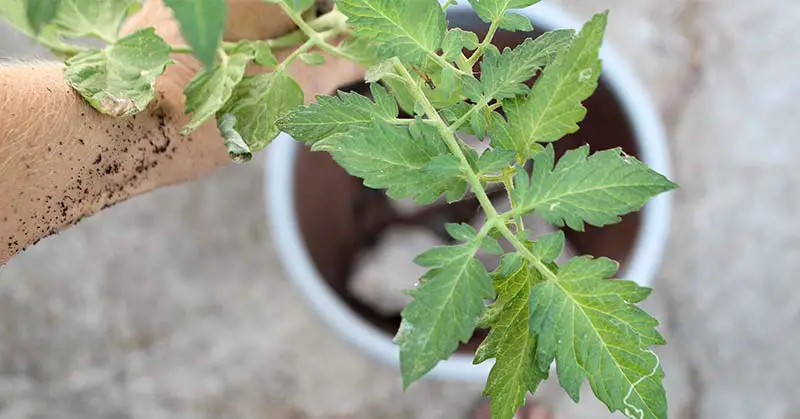Tomato Plants Turning Purple: Tips and Tricks
“Tomato Plants Turning Purple” is a phenomenon that can startle any gardener. Though vibrant green is the color, we typically associate with healthy tomato plants, these essential garden crops can sometimes exhibit an unusual purple hue. This shift in coloration can be a symptom of various underlying issues, from nutrient deficiencies to environmental stressors.
As gardeners, understanding the causes and implications of this unexpected change is crucial to maintaining the health and productivity of your tomato plants.
This blog post aims to delve into this fascinating topic, exploring why tomato plants turn purple, the science behind the change, and how you can ensure your tomatoes stay green and thriving.
Significance of Understanding Why Tomato Plants Turn Purple
Understanding why tomato plants turn purple is crucial for several reasons:
Plant Health Assessment: The change in color of a tomato plant’s leaves can indicate a health problem. Like other living organisms, plants show symptoms when they are not in optimal health. A purple tint can serve as an early warning sign, allowing you to intervene before the plant’s condition worsens.
Optimal Growth and Yield: By diagnosing and addressing the root causes of the purple hue, you can ensure that the plant continues to grow well and yield a plentiful harvest. Ignoring these signs could lead to stunted growth and reduced fruit yield and quality.
Effective Resource Management: When you understand the issues affecting your plants, you can manage your resources more effectively, saving time and money. You’ll be able to provide the right type and amount of care – like water, sunlight, and fertilizer – that your plants need to thrive.
Prevention of Disease Spread: Some causes of purple leaves could be infectious diseases that may spread to other plants. Recognizing and addressing these issues early can prevent the disease from spreading to other plants in your garden or greenhouse.
Enhanced Knowledge and Skills: The more you understand the health and care of your tomato plants, the better you become a gardener. You’ll be able to apply this knowledge to the care of other plants in your garden, making you a more skilled and successful gardener overall.

The Phenomenon: Tomato Plants Turning Purple
Tomato plants turning purple is a phenomenon that is not often seen, but when it does occur, it’s typically a cause for concern among gardeners. This color change usually manifests in the leaves, particularly along the veins or the underside of the foliage. In some cases, the plant stems may also develop a purplish tinge.
The purple coloration often indicates that the plant is experiencing stress or lacking certain essential nutrients. It’s a defensive response of the plant to various conditions unfavorable to its typical growth and development.
When you see tomato plants turning purple, they are trying to tell you something: they are under stress or lacking something they need to remain healthy.
While this phenomenon may look alarming, it’s important to note that it’s a symptom rather than a disease. In other words, purple indicates something is off with the plant’s environment, care, or nutrition.
By understanding what causes this symptom and how to address it, gardeners can restore their plants to health and prevent recurring issues.
Main Factors That Can Cause This Phenomenon
Several factors could contribute to tomato plants turning purple, with the most common ones being:
Cold Stress: Tomato plants are warm-season crops that thrive best in temperatures between 55°F and 85°F. When temperatures drop below this range, especially at night, tomato plants may react by developing purple pigmentation, particularly on their undersides. This is a defensive response to stress, as cold temperatures can slow or halt the plant’s growth.
Phosphorus Deficiency: Phosphorus is a vital nutrient that supports a plant’s overall growth, flowering, and fruit production. It also plays a key role in energy transfer and storage. For example, when a tomato plant lacks sufficient phosphorus, it may respond by turning its leaves purple.
This is because phosphorus deficiency affects the process of photosynthesis, causing an accumulation of sugars in the leaves that boosts the production of anthocyanin pigments, resulting in a purple color.
Genetic Factors: Certain varieties of tomato plants naturally produce purple pigmentation in their leaves and stems due to their genetic makeup. These types usually have a higher content of anthocyanins, naturally occurring pigments in the plants.
Prolonged Periods of Stress or Poor Growing Conditions: These could include insufficient light, overwatering, poor soil quality, or even disease stress. When tomato plants are exposed to such conditions for extended periods, it may lead to purpling as an indicator of their distress.
Remember, purple leaves or stems on your tomato plants are signs that something needs to be addressed in their care or environment. By determining the cause, you can implement corrective actions and improve the health of your tomato plants.
How to Identify the Cause
Identifying the cause of your tomato plants turning purple involves a process of observation and elimination. Here are some steps to guide you:
Observe the Weather: Check for significant weather changes and shallow temperatures. Cold stress can lead to the purple coloration of leaves in tomato plants. Note the nighttime temperatures especially.
Check for Nutrient Deficiencies: Look at the general condition of your plant. For example, if you see slow growth, a poor root system, or fewer fruits, your plant might be experiencing a phosphorus deficiency. A soil test can confirm whether your soil is deficient in phosphorus or other essential nutrients.
Consider the Tomato Variety: Some varieties of tomatoes naturally develop a purple hue in their leaves and stems, particularly under high light intensity. However, if you’re growing a variety known for this trait, purple might be normal.
Examine Overall Growing Conditions: Evaluate the plant’s access to sunlight, the soil’s drainage capacity, and your watering routine. Too much water, poor drainage, or insufficient light can stress the plant and cause purple pigmentation.
Look for Other Symptoms: Signs of disease or pests, such as spots, lesions, wilting, or curling leaves, could also lead to purple leaves. Consulting a plant disease diagnostic lab or a local extension service might be a good idea if you observe any of these symptoms along with the purpling.
Treatment and Prevention
Once you’ve identified the cause of your tomato plants turning purple, you can implement suitable strategies for treatment and prevention:
Addressing Cold Stress
- Protect young plants with covers or bring potted plants indoors at night to protect them from cold temperatures.
- Avoid planting tomatoes outdoors until after the last expected frost date, when temperatures are reliably above 55°F, especially at night.
Rectifying Phosphorus Deficiency
- Use a balanced fertilizer that includes phosphorus (the middle number in the fertilizer ratio, e.g., 10-10-10).
- Add bone meal or rock phosphate to your soil, as they are natural sources of phosphorus.
- Ensure your soil pH is between 6.0 and 7.0, as pH outside this range can inhibit phosphorus uptake.
Improving Growing Conditions
- Ensure your plants receive full sunlight, ideally 6 to 8 hours daily.
- Water your plants properly; the soil should be moist but not waterlogged. Overwatering can lead to root problems that impede nutrient uptake.
- Improve soil quality and structure by adding compost or other organic matter, which can help enhance nutrient availability.
Preventing Future Issues
- Regularly test your soil to monitor nutrient levels and pH, and amend it as necessary.
- Practice crop rotation to help prevent the buildup of diseases in the soil.
- Choose tomato varieties adapted to your local climate conditions, and consider varieties with natural resistance to common diseases.
Final Thoughts
“Tomato Plants Turning Purple” is a significant phenomenon that highlights the delicate balance between a plant and its environment. This color change signals that your plants require attention due to cold stress, nutrient deficiencies, or specific genetic factors.
As we have explored, understanding the causes, the science behind the color change, and implementing appropriate interventions are vital to ensuring your tomato plants thrive.
A garden of healthy, green tomato plants promises a bountiful harvest and symbolizes effective and attentive care from a well-informed gardener.


